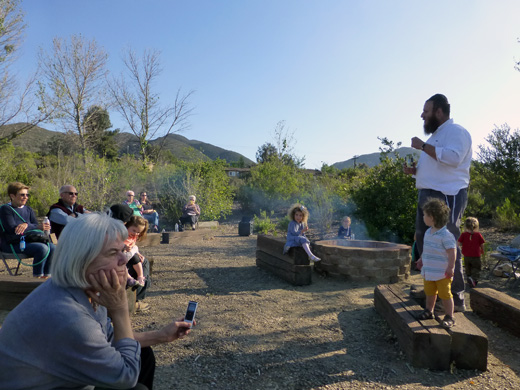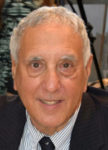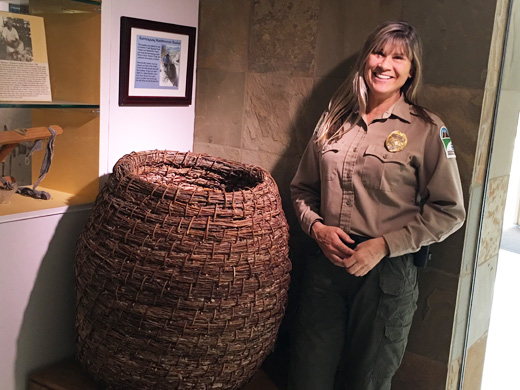
By Donald H. Harrison

SAN DIEGO – Two ancient traditions briefly were juxtaposed on Thursday, May 3, as Chabad of East County celebrated the Jewish holiday of Lag B’Omer at the foot of Kwaaypay (Chief, Headman) Peak at the Kumeyaay Lake Campgrounds in Mission Trails Regional Park.
When the indigenous Kumeyaay were a semi-nomadic people, they followed the San Diego River from the beaches to the mountains, from which they took side trips to the desert–and then they came back the way they came, camping during the winter at sites along the river in today’s Mission Trails Regional Park.
Ranger Heidi Gutknecht, whom I interviewed the day before Lag B’Omer, commented that “Next door to the San Diego River there is an historic grinding rocks area where you can see worn away basins,” created by Kumeyaay women who pounded acorns with their pestles, known as “morteros.”

The reason the Kumeyaay chose Mission Trails Regional Park, Gutknecht said, was “where there is water there will be plants and animals. Mother Nature was like their Walmart, their store, to get everything. … We have mule deer here, a prize prey for the Kumeyaay who never let anything go to waste. They not only ate the meat and kept the fur but they saved the antlers which could be used as tools; and bones, hoofs and rattles for ceremonial purposes. The Kumeyaay didn’t play drums like other tribes; they played rattles – primarily gourd rattles from wild squash. Deer toe rattles were for more special ceremonies. Gourd rattles were for regular song cycles, songs that told their stories in the oral tradition, as they had no written language.”
Chabad Rabbi Rafi Andrusier stood on a log on Thursday and spoke to an assemblage of parents and children, who had enjoyed at their campfire not the acorn meal and mule deer meat beloved by the ancient Kumeyaay, but toasted marshmallows, hamburgers, hotdogs, and various salads, all kosher, of course.
He didn’t sing the song of his people’s history, accompanied by the sound of gourd rattles, as the Kumeyaay might have, but he did tell the story of Lag B’Omer, thereby engaging in passing on a part of Judaism orally.
Rabbi Andrusier pointed out that this is the time of the Omer, the counting of the 49 days between Pesach and Shavuot, and that the 33rd day of the Omer is a special day. Sometimes, he quipped, people say “lag sameach” rather than “hag sameach.” The latter expression means “happy holiday.” The word “lag” in Hebrew is a contraction of the letters lamed, which stands for the number 30, and gimel, which stands for the number 3. Together, they represent the number 33, thus the name “Lag B’Omer.”
He told of Rabbi Akiva, a wonder rabbi who lived in Israel during the second century. Like he Kumeyaay, for the first 40 years of his life, Rabbi Akiva was a man of the land, who earned his living tending sheep. He married the daughter of a very wealthy family. His bride’s father was incensed that the daughter would pick such a man, who was unlearned and poor. He disinherited her.
“But,” Rabbi Andrusier instructed, “she had confidence and faith in her husband that he could become a great sage and a great scholar. Eventually he did. One day, he was out shepherding the flock and he passed by a stream.” He noticed that water dripping drop after drop on a stone had begun to wear an indentation in the stone.
In contrast to the pestle used by the Kumeyaay to pound the acorns on the grinding rocks, the indentation that Rabbi Akiva saw was created by water. “He thought if something as soft as water can penetrate something as hard as stone,” then perhaps Torah learning could even penetrate his brain. So at the age of 40, Akiva started to learn Torah, sitting in a cheder with little children to learn the Hebrew alphabet. “Eventually he became one of the greatest Torah scholars.”
However, the thousands of students whom Rabbi Akiva accumulated did not pay respect to each other, and a plague caused the death of 24,000 of them—one reason why the period of the Omer is such a mournful time. But on the 33rd day, the plague stopped, so it was a cause for celebration.
“But more than that,” Andrusier told those seated near him around the campfire. “One of the surviving students of Rabbi Akiva was Rabbi Shimon bar Yochai, who was the author of the Zohar, the first Kabbalistic work that we have. He said that ‘on the day I die, it should be a day of celebration.’ Who celebrates on the day someone dies? We make a yahrzeit; we don’t go out into the field and make a fire. So why do we have a bonfire on the day of Rabbi Shimon bar Yochai’s passing?”
He answered his question saying “He was a mystic, a man of great soul and great spirit. Fire is like the spirit, and he looked at the world in a different way than most people. He saw infinite potential in every moment of existence, and he lived and breathed that.” The final day of his life “was the culmination of his work; it was when all the pieces came together. So, he said, ‘The day of my passing is not a sad day; it is a wonderful day’ and ever since, it has been a tradition to have a bonfire on Lag B’Omer and to celebrate.
Rabbi Andrusier told one more story, standing there on the log at the campfire. It seems there was a couple in Israel who desperately wanted to have children, but after years of marriage, still no children came. Perhaps, said the husband, they should divorce because they want children but can’t have children with each other. So, they decided to have a ‘divorce party,’ which their friends attended, so amicable was their relationship. The husband, who was wealthy, declared that his wife may take any treasure in his household, no matter what it might be. And the wife, a wise and clever woman, declared that the one single thing that she wanted was her husband.
The couple decided to stay together, and they went to the town of Meron, where Rabbi Shimon bar Yochai is buried, and prayed there for the blessing of a child. The blessing was granted, after all those many years. Today Rabbi Bar Yochai’s gravesite is a place of pilgrimage – especially on Lag B’Omer.
The Kumeyaay and the ancient Jews were very different people, with very distinct lifestyles and beliefs. But every society has points of intersection with every other.
*
Harrison is editor of San Diego Jewish World. He may be contacted via donald.harrison@sdjewishworld.com